This article is part of a series. For the beginning of this series, please see our previous article.
Stretched Budgets
The flurry of benefaction in which the Nettleship Library had been established could not last indefinitely and, in 1903-4, the committee reported that the budget for books had fallen again.
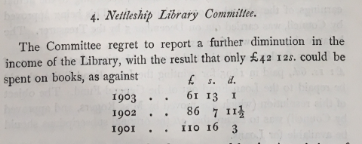
To continue to finance the A.E.W., the Nettleship was contributing £10 a year in subscriptions. Meanwhile a grant from the Association of History Tutors to the Library, which had in the preceding years averaged £61, was not awarded.
In 1905-6, with book budgets still stretched, the Librarians of the Societies of Women’s Students opted to (conditionally) open their Science collections to all A.E.W. students. By doing so, each library could concentrate on one particular Science specialism with the Nettleship electing to focus on certain periodicals.
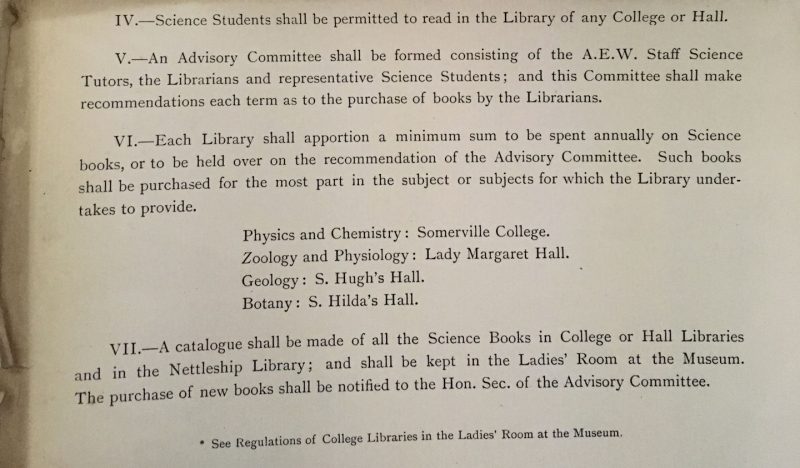
In 1907-8 the Nettleship Library exceeded 5000 volumes and in 1904-5, the Honorary Librarian of the Nettleship’s name had appeared for the first time on the list of Officers in the A.E.W. Annual Report. Though a minor change, this nevertheless implied an increase in standing and respect for what was becoming a role with significant responsibility. Entries in the balance sheet entitled ‘Additional Assistance’ were echoed by a call for additional Library funding to support the growing work of the librarians. Loans during this period amounted to around 1000 per term and about half this number over each vacation.
Reclassification and Modernisation
In 1910, the Library had outgrown the organisation of its initial classification scheme and after much consultation with the other librarians of the women’s halls, it was decided to adopt the Dewey Decimal System. Now famous across the world, the scheme was still relatively new in 1910 but already in use at the libraries of Lady Margaret Hall and Somerville College. Special project staffing was arranged in the form of Miss E. O. Bell, who had been trained at the Bodleian. It was only that year that the first female librarian at the Bodleian had been appointed. (Archived by the wayback machine at: https://web.archive.org/web/20210227121831/https://www.bodleian.ox.ac.uk/news/2016/oct-18#expand)
The Bodleian’s Miss Bell and the Nettleship’s Assistant Librarian, Miss V. A. Bonner worked through the summer with “the indefatigable help of many kind volunteers” [p9, 1910-11, A.E.W. Annual Report] to complete the work by October 1911 and the start of Michaelmas Term.
“The Committee believe that, though some small changes will doubtless yet be found desirable, the foundations of a clear and convenient system have been permanently laid, with proper provision for future expansion.”
[p9, 1910-11, A.E.W. Annual Report]
This has proven true as at the time of writing, over one hundred years later, St Anne’s College Library still use an only slightly modified Dewey Decimal Classification.
The newly organised Library was also improved in the same year by the introduction of an additional member of staff. Miss C. E. L. Smith joined the Librarian and Assistant Librarian as a Library Clerk and by doing so, enabled the staffed opening hours to be increased until 1:20pm; something which, in the minds of many A.E.W. students, was long overdue.
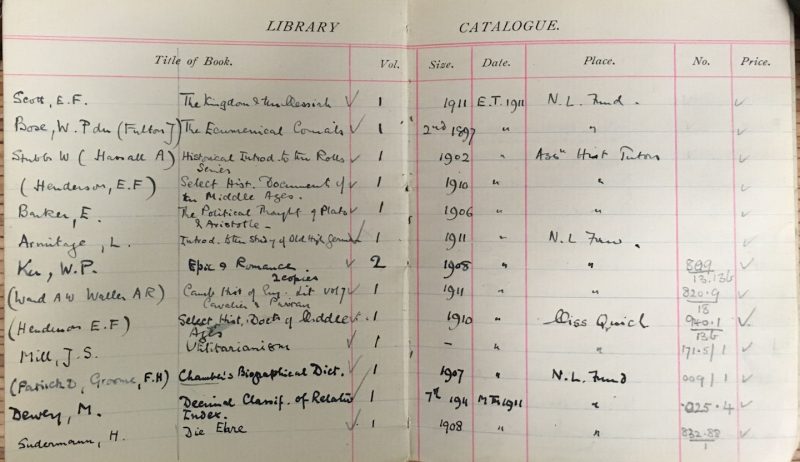
Electric lighting was installed in the Office and Reading Room in 1912, enabling them to remain open until 5:45 in term time (the Bodleian next door didn’t receive electric lighting for another 17 years, in 1929). Finances had recovered somewhat from the previous decade and by the following year (1913), the librarians were able to spend £100 on books. Library loans were up and the Committee put this down largely to the work of the Sub-Librarian (whose post had subsumed that of Library Clerk) based in the Reading Room to issue books from 10am until 1:15pm every day. [p7-8, 1913-14, A.E.W. Annual Report].
Funds were stretched during the war as the whole city tightened purse strings but the collection continued to grow at a steady pace of several hundred volumes a year. The Library was able to donate some 100 or so withdrawn books to a ‘Prisoners of War Book Scheme’ and by 1918 had a healthy book budget again and a collection that numbered over 8000 for the first time. D. M. Bigg, the Librarian, reported that loans were up to 3554 volumes over the three terms, though vacation borrowing had fallen to 1800, a figure which she put down to wartime railway restrictions. During the war, Somerville students had been temporarily rehoused in Oriel College and made much use of the Nettleship during this time. [p5, 1918-19, A.E.W. Annual Report].
Other Goings On
The Society of Oxford Home-Students had acquired the first true space of their own in 1910. The rental of rooms at 16 Ship Street in central Oxford allowed for the establishment of a Common Room for the students which was furnished with tables and chairs and could be used as a meeting place for clubs and societies.
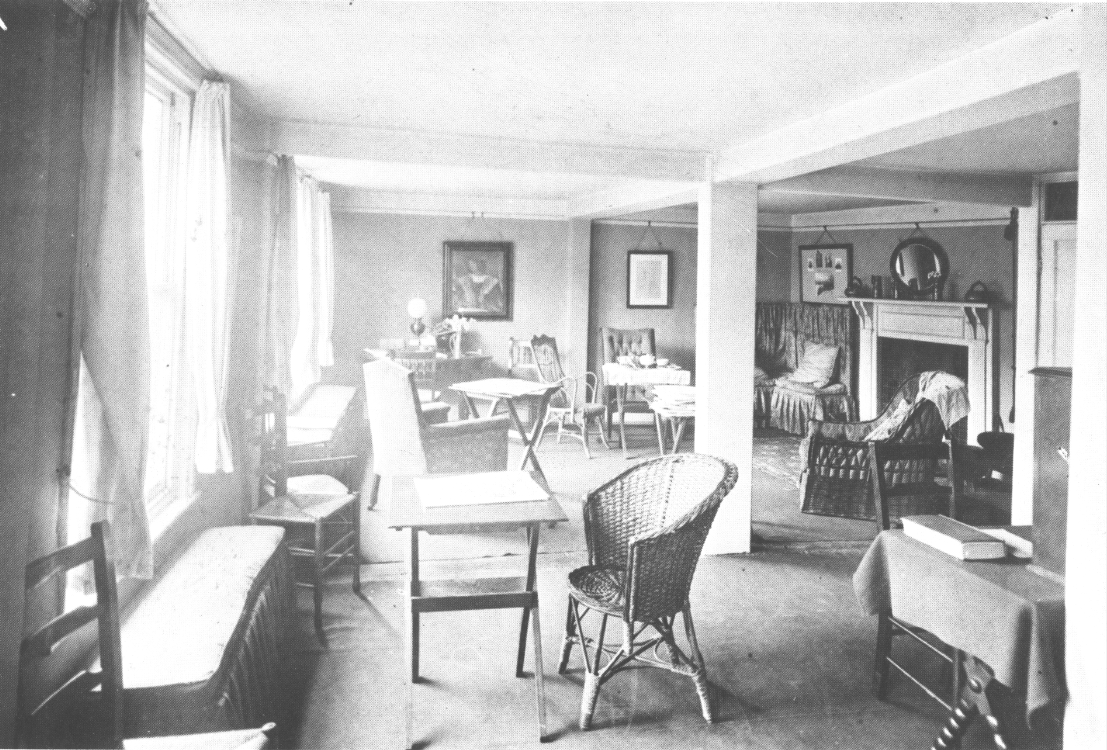
In 1915 a fiction library ‘The Inter-Collegiate Library of Modern Literature’ was established at Ship Street. For a fee of 1s. 6d. students from any of the women’s societies would have access to a range of modern fiction titles which were outside the collection policy of the Nettleship Library. The Fiction Library was run by students and in its first year had 50 members from across the societies.
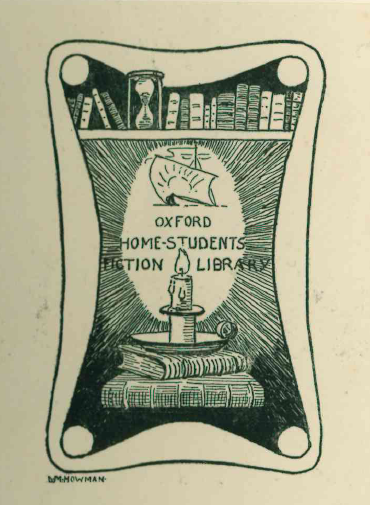
Bibliography
- Association for Promoting the Education of Women in Oxford. [1895-]. Association for the Education of Women, Oxford : Home Students : Annual Report.
- The Fritillary [1894-1931?] (https://issuu.com/oxfordwomenscollegeshub)
This article was written and researched by Duncan Jones (Reader Services Librarian) building on research by Clare White (Librarian).